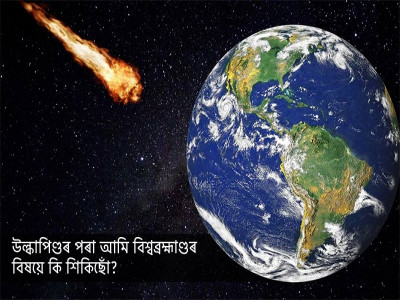
"EARTH IS FLAT" - FLAT EARTHERS (VS ROUND EARTHERS)
Flat earthers believe that the Earth is not spherical but rather
flat, with the North Pole at the centre and Antarctica forming a wall of ice
around the edges to prevent people from falling off. They often argue that
pictures of the Earth from space are fake and that gravity is not a real force.
They claim that the horizon always appears flat and that the Sun, Moon, and
stars are actually much closer to the Earth than scientists suggest.
Round earthers, on the other hand, believe that the Earth is an oblate spheroid or a sphere that is slightly flattened at the poles and bulges at the equator. This shape is supported by various scientific evidence, including measurements of Earth's gravity and satellite images. They maintain that the curvature of the Earth can be observed from high-altitude flights and that the round shape has been confirmed by human spaceflight and global positioning systems (GPS).
The debate between flat earthers and round earthers is largely a matter of scientific evidence, with round earthers appealing to empirical data and flat earthers relying on isolated observations and conspiracy theories. However, it should be noted that flat earthers often view their beliefs as a rejection of mainstream science and as a form of individualism or dissent. As for me, I support the scientific evidence that the Earth is not flat.
Flat earth theory and the arguments
Flat earth theory is the belief that the Earth is not a rotating sphere, but a flat, disc-shaped plane. Proponents of this theory reject the scientific consensus that the Earth is an oblate spheroid and argue that all evidence supporting a spherical Earth, such as photographs from space and the curvature of the horizon, are falsified or misinterpreted. Flat earthers often argue that gravity is not a force that holds objects to the Earth's surface, but a downward acceleration caused by the flat Earth accelerating upward.
This belief has been debunked by scientific evidence for centuries, dating back to ancient Greece. The idea of a flat Earth was largely dismissed by the scientific community during the Age of Enlightenment, but it has persisted in certain pockets of society and has experienced a resurgence in recent years thanks in part to the internet and social media.
Flat earthers have a number of arguments to support their belief that the Earth is flat, including:
1. The horizon always appears to be flat: Flat earthers argue that if the Earth were round, the horizon would appear curved, but in reality, it appears flat.
2. Lack of visible curvature from high-altitude photography: Flat earthers claim that all photographs from space are computer-generated or photoshopped and that they have personally seen no evidence of curvature in high-altitude photography. They claim that there is no visible curvature in photographs of the Earth taken from space and that the horizon always appears level.
3. Gravity is not a real force: Flat earthers argue that the concept of gravity is flawed and that objects do not fall towards the Earth due to a gravitational force pulling them down, but rather because of a natural acceleration that has yet to be discovered. According to them, gravity is not a real force but is instead an illusion caused by the Earth accelerating upwards.
4. Flight paths do not account for a spherical Earth: Flat earthers argue that if the Earth was a sphere, flight paths would need to be adjusted for the curvature of the Earth, which they claim is not evident in flight patterns.
5. The Bible supports a flat Earth: Some flat earthers argue that religious texts, such as the Bible, describe the Earth as flat, and therefore that is what it must be.
6. Conspiracy theory: They believe that the round Earth theory is part of a vast conspiracy involving scientists, governments, and other organizations to hide the truth from the public.
7. Lack of direct personal experience: Some Flat Earthers argue that they have never personally experienced the Earth's curvature, and thus conclude that it does not exist.
Earth, according to Scientific evidence
According to NASA scientists, the shape of Earth is an oblate
spheroid, which means it is mostly spherical with a slight bulge around the
equator and some flattening at the poles. This shape can be compared to that of
a squashed ball or an orange. The equatorial diameter of the Earth is about
12,742 kilometres and the polar diameter is about 12,714 kilometres. The slight
bulging at the equator is due to the Earth's rotation, which causes the
centrifugal force to push outwards at the equator. This shape has been
scientifically proven through various observation methods such as satellite
imagery, radar measurements, and gravity measurements.
The Earth's oblate spheroidal shape is a result of several factors:
1. Rotation: The Earth's rotation causes it to bulge slightly at the equator due to the centrifugal force generated by its spin.
2. Gravity: The gravitational pull of Earth's mass on itself causes compression toward the centre. This flattens the poles slightly and makes the equator bulge.
3. Earth's interior: Earth's interior is not uniform, and the density of its layers varies. This uneven distribution of mass generates variations in gravitational attraction, which contributes to the shape.
4. Collision with other celestial objects: Scientists believe that early in its history, Earth may have been bombarded by large objects that caused its shape to become more flattened at the poles.
All of these factors combined have influenced the Earth's shape over time, leading to the oblate spheroid we know today.
How can the Earth never be flat?
Earth cannot be flat because of numerous scientific pieces of
evidence and experiments that have been carried out over centuries. Many lines
of evidence demonstrate that the Earth is not flat, but is instead a rotating
sphere.
Here are some reasons why Earth is not flat:
1. Observations and Satellite imagery from space: Astronauts aboard the International Space Station, satellites, and other spacecraft have taken countless photographs of Earth showing its spherical shape. Images of the Earth taken from space show a curved surface, with a clear horizon that appears to drop away from the observer.
2. Gravity: The force of gravity on Earth is consistent with the planet's spherical shape. The gravitational pull from a spherical body is different from that of a flat surface. The force of gravity on Earth pulls objects towards the centre of the planet. This force is consistent with the Earth being a sphere, but would not work as expected if the Earth were flat.
3. The way Earth casts shadows during Lunar Eclipse: During a lunar eclipse, the Earth casts a curved shadow on the Moon. The shape of the Earth's shadow as it falls on the Moon during a lunar eclipse is evidently curved and the shape of this shadow is consistent with the Earth being a sphere.
4. The behaviour of water: Water at rest or in motion always seeks to be level, which is only possible on a curved surface.
5. Observations of the night sky and the apparent shape of celestial objects: Objects in the night sky, such as the Moon, planets, and stars, appear circular to the naked eye and move in circular paths around Earth. The constellations that are visible in the night sky change depending on where you are on Earth. This is because the Earth is curved, and the angle at which you see the stars changes as you move around the planet.
6. Ships and buildings disappearing over the horizon: If the Earth were flat, you would be able to see objects on the horizon no matter how far away they were. However, in reality, ships and buildings disappear over the horizon because they are obscured by the curvature of the Earth.
Overall, flat earthers argue that there is a vast conspiracy to
cover up the truth about the Earth's true shape and that the scientific
community and government institutions are complicit in spreading perceived lies
about the Earth being a sphere. However, It is important to note that these
arguments have been widely debunked by the scientific community and that there
is a wealth of scientific evidence that supports the idea that the Earth is
round. This evidence comes from many different sources, including observations
of the Earth's curvature from high-altitude aircraft and satellites, the
behaviour of gravity and the fact that people in different parts of the world
experience different constellations in the night sky.
In conclusion, all available evidence, including scientific experiments and observations, point towards Earth as a spherical object, and not flat as believed by flat earthers. The flat Earth theory is widely considered a pseudoscientific belief and is not supported by any credible scientific evidence. Despite the overwhelming scientific evidence to the contrary, the flat Earth theory continues to be propagated on the internet and in some fringe communities.
Disclaimer: The opinions expressed in this article are those of the author's. They do not purport to reflect the opinions or views of The Critical Script or its editor.

Newsletter!!!
Subscribe to our weekly Newsletter and stay tuned.

















Related Comments